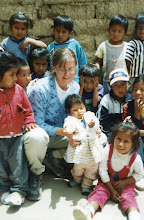
After sharing so many bucolic scenes surrounding the therapeutic center as part of my work for Voces Para Cochabamba, I will now bring you down to earth with some of the day to day reality of life for children and teens living on their own in the streets of Cochabamba. The above image, that was used for communication posters and postcards, speaks of the over 500 children/youth that remain living here on the streets of Cochabamba, slowly loosing their lives. It goes on to say "For what are you waiting? S.O.S."
The eerie part of this poster created in this year, 2012, is that among the 15 disguised faces of homeless children surviving on the streets, three have died just this year. Adding their names to the growing list of children/youth that have died in the streets of Cochabamba.

The problem is complex, and I will share bit by bit over the next few months my understanding of the situation. First of all a little background. There are hundreds of groups that work with children and adolescents in the city of Cochabamba, as a recent statistic stated over 38,000 children are at risk in this city of being left out or put out on the streets or desire to runaway from their dysfunctional homes. These programs are varied and include the programs like the ones I worked with at the Parish of San Carlos. The before and after school and lunch programs, have teachers and social workers working with and keeping a watch on the children, a one type of prevention program.
There are scores of orphanages that have children dropped off constantly, as well as children who are abandoned in the market place. These children usually are not technically orphans as their parent are still alive, their parents are just unable or do not want to care for their children. Unfortunately adoption remains a stigma here in Bolivia. I met a couple who had adopted a baby, their friends were quick to tell me that it is a secret, they wanted to keep it that way, so I could not congratulate them on adoption. Too bad the doors aren't open to the US, with so many good parents waiting for a chance.

Teens are also abandoned to homes for teens, a place where runaways may also be brought to. There are also night shelters for kids, a nice place to stay (if you have been living on the street) to have dinner, take a shower, wash clothes and maybe store things until the next night. There are also other homes with programs and long term stays, they are all voluntary.
There are many outreach programs that bring clothes and food, but they could be considered enabling children to remain on the street. If people bring you food, clean clothes, and you have a nice dry bridge to sleep under with friends, what is your incentive to get off the streets. In a country where a large percentage of college grads never find a professional job, what kind of job would a child with 3rd grade education find. Besides should children be working??
One of my organization's (Voces Para Cochabamba) goals is to create a coordination amongst all the groups that work directly with this population, so as to actually create steps between the various programs, a tool to lead each child to success, and not to hop scotch between the lower steps of programs.
The pictures of the post are copyrighted and provided by Voces Para Cochabamba and/or Voces Para Latinoamerica, with permission.





No comments:
Post a Comment